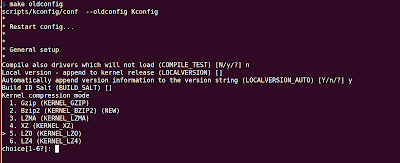make config vs oldconfig vs defconfig vs menuconfig vs savedefconfig
Building the Linux Kernel is a two-step process:
make menuconfig:
- Configuring the Kernel options
- Building the Kernel with those options.
There are many methods available for configuring the kernel.
make config:
- Text-based Configuration.
- Options are prompted one after another.
- All options need to be answered
- Access to former options is not possible
make menuconfig:
- Menu-driven user interface
- Allows to navigate forwards and backward directly between features
- Allows to load and save files with filenames different from ".config"
- Provides search feature
- It uses ncurses library for GUI. If the ncurses library is not installed, make menuconfig option fails. To install ncurses library on Ubuntu: sudo apt-get install libncurses5-dev
make defconfig:
Creates a ".config" file with default options from the ARCH supplied defconfig
Configurations are generally stored in the directory: arch/$(ARCH)/configs
$ ls arch/x86/configs/
i386_defconfig tiny.config x86_64_defconfig xen.config
When you run "make defconfig" on "x86" machine, it copies the configuration options from "i386_defconfig". On "X86_64" machine, it copies the configuration options from "x86_64_defconfig".
My system was "x86_64", so it copied kernel configuration from 'x86_64_defconfig'
When you are cross compiling, and there will be default configuration for that particular board in arch/(ARCH)/configs folder.
make oldconfig:
- Reads the existing .config file and prompts the user for options in the current kernel source not found in the .config file.
- Useful when you are moving the existing kernel configuration to a new kernel version.
- If you run 'make oldconfig' second time after you have run it once, the second time will not ask you any options
make savedefconfig:
- Creates a 'defconfig' file for you in the current directory.
- Used when you do a 'make defconfig' and modified few configuration changes as per your new board
Note: New defconfig file name should end with "_defconfig"








Very useful content Offset Printing Company in Tirupur | Four Dots
ReplyDelete